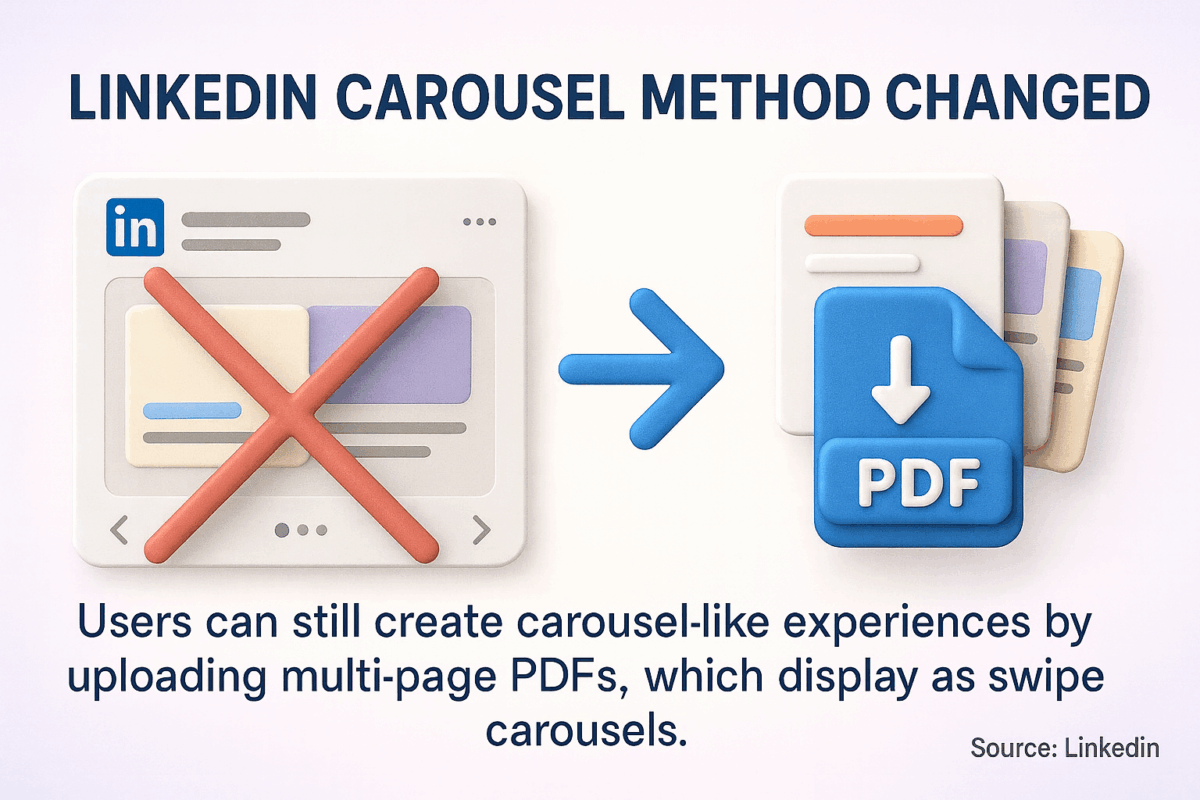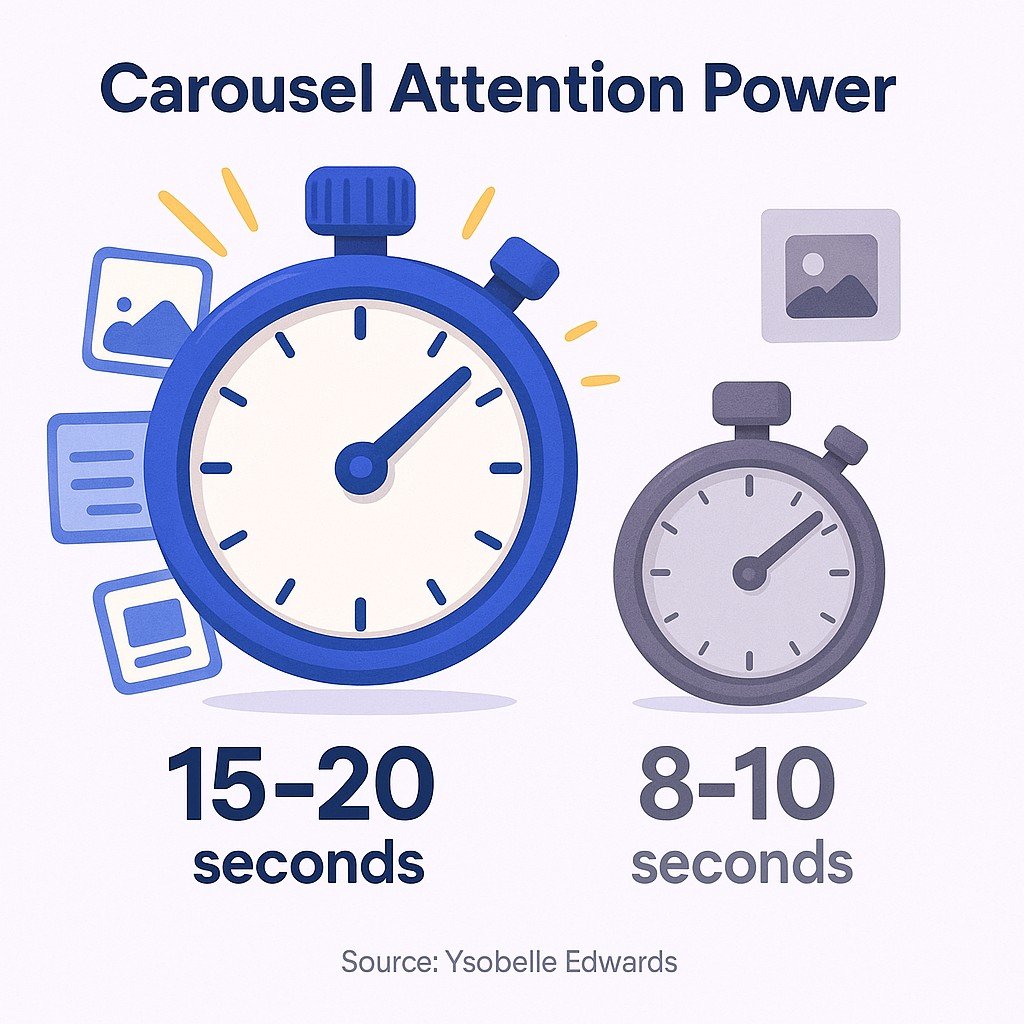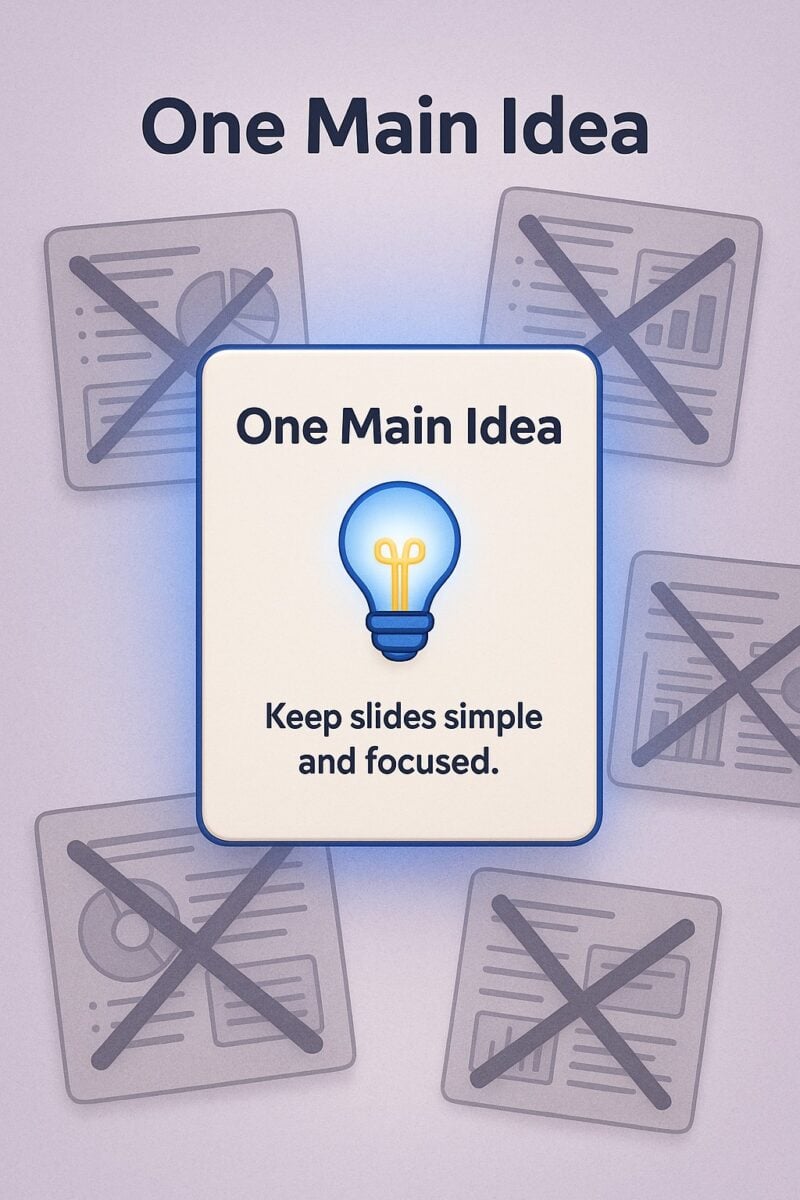LinkedIn carousel posts let you share multi-slide content that viewers can swipe through horizontally on both desktop and mobile devices. But here’s what most people miss: LinkedIn quietly changed how carousels work. As of 2024, LinkedIn’s native carousel post feature for organic posts was discontinued, but users can still create carousel-like experiences by uploading multi-page PDFs, which display as swipeable carousels.
 In 2024, LinkedIn discontinued native carousel posts for organic content—use multi-page PDFs to create swipeable carousels.
In 2024, LinkedIn discontinued native carousel posts for organic content—use multi-page PDFs to create swipeable carousels.This shift caught many marketers off guard. You might have noticed your old carousel creation method stopped working. The good news? The PDF method actually works better for professional content. You get cleaner layouts, better text readability, and more control over your design.
I’ve been tracking LinkedIn’s content format changes since 2008, and this carousel evolution makes sense. LinkedIn wants business-quality content, not just social media eye candy. The platform rewards thoughtful, educational carousel posts with better organic reach.
You’ll learn how to create both organic PDF carousels and paid carousel ads. I’ll show you the design specs, content strategies that actually work, and performance metrics to track. Plus, I’ll share which tools make carousel creation fast and professional-looking.
How LinkedIn Carousels Actually Work Now
The carousel format remains powerful for engagement, but the creation process changed completely. Understanding both organic and paid carousel options helps you choose the right approach for your goals.
Organic Carousel Posts Through PDF Upload
Carousel posts on LinkedIn can be created by uploading a multi-page PDF document where each page becomes a slide for organic posts. This method replaced the old multi-image upload feature that LinkedIn removed.
When you upload a PDF to LinkedIn, the platform automatically converts each page into a swipeable slide. Users see your first page in their feed and can swipe right to view additional pages. This creates an engaging, interactive experience that stands out from standard text or single-image posts.
The PDF approach offers significant advantages. You maintain complete control over typography, layout, and branding. Text remains sharp and readable at any size. You can include charts, graphs, and detailed information that would be difficult to fit in a standard post.
| PDF Carousel Features | Benefits | Limitations |
|---|
| Multi-page document upload | Professional layout control | Requires PDF creation skills |
| Automatic slide conversion | Sharp text and graphics | No individual slide URLs |
| Horizontal swiping | Engaging user experience | Limited to PDF format only |
LinkedIn carousel ads allow advertisers to upload multiple images for sponsored content, with each card featuring unique headlines and destination URLs. This paid option gives you more flexibility than organic PDF posts.
Carousel ads work differently from organic posts. For carousel ads, LinkedIn recommends using between 2 and 10 cards, with each card sized at 1080 x 1080 pixels (1:1 aspect ratio) and a maximum file size of 10 MB per image. Each card can link to a different landing page, making them perfect for showcasing multiple products or services.
The advertising platform provides detailed targeting options. You can reach specific job titles, company sizes, or industries. LinkedIn carousel ads support both desktop and mobile placements, ensuring broad reach across the platform’s professional audience.
Creating High-Performance Organic Carousel Posts
Now that you understand how PDF carousels work, let’s build one that actually gets engagement. The key is treating each page like a chapter in a story, not random slides thrown together.
Design and Technical Specifications
Start with the right dimensions and file setup. Create your PDF with pages sized at 1080 x 1080 pixels for optimal mobile display. This square format works best across all LinkedIn placements and device types.
Tools like Adobe Express, Canva, Adobe Illustrator, and PowerPoint are commonly used to design LinkedIn carousel slides, as they allow for easy export to PDF and precise control over layout and branding. Each tool has specific strengths for different skill levels and design needs.
- Adobe Express and Canva: Pre-built LinkedIn carousel templates with drag-and-drop editing
- PowerPoint: Familiar interface with professional layout options
- Adobe Illustrator: Advanced design control for custom graphics and typography
Keep file sizes reasonable. LinkedIn processes large PDFs slowly, which can delay your post going live. Aim for under 10 MB total file size by optimizing images before adding them to your design tool.
Supported file types for organic carousel posts require the file to be in PDF format, unlike carousel ads which accept JPG, PNG, and GIF formats. This limitation actually helps maintain quality and consistency across your carousel presentation.
Content Strategy and Structure
Effective carousel posts follow a clear narrative structure. Think like a book: compelling cover, logical chapters, and strong conclusion. Each slide should advance your main message while standing alone if someone sees it out of context.
Start with a problem or question your audience faces. Your first slide acts as the hook, similar to a blog post headline. Use bold text and minimal words to grab attention as people scroll through their feed.
Structure your carousel with these elements:
- Hook slide: Problem statement or intriguing question (slide 1)
- Content slides: Solutions, tips, or educational content (slides 2-8)
- Call-to-action slide: Next steps or engagement request (final slide)
Limit text to 2-3 key points per slide. LinkedIn users scroll quickly, so dense text blocks get ignored. Use bullet points, short sentences, and plenty of white space to improve readability on mobile devices.
Is Your LinkedIn Working?
Just released: my new book to help professionals, entrepreneurs, and business owners maximize LinkedIn for real growth.
With years of LinkedIn expertise, Maximizing LinkedIn for Business Growth offers actionable steps to build your brand, expand your network, and drive results.
Start leveraging LinkedIn like never before—grab your copy now! Click the cover or button below to buy on Amazon.
A common concern is whether carousel posts perform well on LinkedIn. Carousel posts are highly engaging, with studies showing carousel-style content maintains user attention longer than other formats, with average dwell times of 15-20 seconds per post compared to 8-10 seconds for single-image or text-only posts.
 Carousel posts hold attention 15-20 seconds vs 8-10 seconds for single-image or text-only posts.
Carousel posts hold attention 15-20 seconds vs 8-10 seconds for single-image or text-only posts.Setting Up LinkedIn Carousel Ads
Paid carousel ads offer targeting precision and measurable results that organic posts can’t match. The setup process requires more steps, but you gain access to LinkedIn’s full advertising toolkit.
Campaign Configuration and Targeting
Access carousel ads through LinkedIn Campaign Manager. Choose your campaign objective first, as this affects available ad formats and optimization options. Carousel ads work best for awareness, consideration, and conversion goals.
Set your target audience using LinkedIn’s professional targeting options. You can reach people by job title, company size, industry, skills, or even specific companies. The platform’s B2B data accuracy makes this targeting highly effective for professional services and enterprise software.
Carousel content is particularly effective for B2B marketers aiming to educate, inform, and nurture leads through visually engaging, multi-step storytelling. This makes carousel ads perfect for complex products or services that need explanation.
Creative Asset Requirements and Setup
Upload between 2 and 10 individual images for your carousel ad. Supported file types for carousel ads include JPG, PNG, and non-animated GIF, giving you more flexibility than organic PDF posts.
Each carousel card needs its own headline and destination URL. This lets you create a cohesive ad that drives traffic to multiple landing pages. For example, a software company could showcase different product features, with each card linking to the relevant product page.
Write unique headlines for each card, even if they’re part of the same story. LinkedIn users might see cards out of order, so each headline should make sense independently. Keep headlines under 45 characters to avoid truncation on mobile devices.
| Carousel Ad Component | Specifications | Best Practices |
|---|
| Image dimensions | 1080 x 1080 pixels (1:1 ratio) | Use consistent visual style across cards |
| File size limit | 10 MB maximum per image | Optimize images for faster loading |
| Headline length | 45 characters maximum | Make each headline standalone clear |
| Number of cards | 2-10 cards per carousel | 5-7 cards work best for most campaigns |
Measuring Carousel Post Performance
Tracking the right metrics helps you improve future carousel posts and justify the time investment. LinkedIn provides different analytics for organic posts versus paid carousel ads.
Organic Post Analytics
LinkedIn’s native analytics show engagement metrics for your organic carousel posts. Look at impressions, clicks, likes, comments, and shares to gauge overall performance. The platform also shows you which specific slides get the most engagement.
Pay attention to completion rates, which tell you how many people swiped through your entire carousel. Low completion rates often indicate weak storytelling or too much text per slide. High completion rates suggest your content maintains interest throughout.
Compare carousel performance to your standard posts. Most LinkedIn users see better engagement from well-designed carousels, but the improvement varies by industry and audience. Creating content that resonates with your specific audience matters more than the format itself.
Paid Campaign Metrics and Optimization
Analytics for carousel ads include metrics such as impressions, clicks, click-through rate (CTR), and engagement rate, which can be tracked via LinkedIn’s Campaign Manager. These detailed metrics help you optimize both creative and targeting.
Monitor which carousel cards perform best. LinkedIn shows card-level performance data, including individual click rates and engagement. This information helps you understand which messages resonate most with your target audience.
LinkedIn carousel ads typically achieve higher engagement rates than single-image ads, with engagement rates for carousels averaging around 5.9% compared to the platform average of 4.2%. These performance benefits justify the extra creative effort required.
Test different carousel sequences with the same content. Sometimes reordering your cards improves overall campaign performance. A/B testing different opening cards helps identify the strongest hooks for your audience.
Common Carousel Mistakes to Avoid
Even experienced LinkedIn marketers make predictable carousel mistakes. Avoiding these issues saves time and improves your results from the start.
The biggest mistake is treating carousels like individual social media posts. Each slide must connect to create a cohesive story. Random tips or unrelated images confuse viewers and reduce engagement. Plan your entire narrative before creating any individual slides.
Another common error is cramming too much text onto each slide. LinkedIn users browse quickly on mobile devices. Dense paragraphs and small fonts get ignored. Stick to one main idea per slide with large, readable text.
 Design tip: stick to one main idea per slide with large, readable text.
Design tip: stick to one main idea per slide with large, readable text.Many people also forget about the preview image. Your first slide determines whether people engage with your carousel or scroll past it. Make that opening slide compelling enough to earn the click, but don’t make it clickbait that disappoints on the subsequent slides.
For paid campaigns, using the same landing page for every carousel card wastes opportunity. LinkedIn carousel ads allow advertisers to add unique headlines and destination URLs to each card, enabling more personalized and targeted messaging within a single ad unit. Take advantage of this feature to create more relevant user experiences.
Quick Answers to Common Carousel Questions
Let me address the questions I hear most often about LinkedIn carousel posts and ads.
Are LinkedIn carousels going away? LinkedIn carousel posts are not going away and remain a prominent feature in the LinkedIn feed as of 2025. The platform continues supporting carousels alongside other formats like videos and standard posts. No credible sources report LinkedIn discontinuing carousel posts.
Do carousel posts do well on LinkedIn? Carousel posts generally perform well on LinkedIn, often achieving higher engagement and organic reach compared to standard posts due to their interactive, multi-slide format and visual appeal. The LinkedIn algorithm tends to boost carousel posts, making them effective for personal branding and audience interaction.
Can you do a carousel ad on LinkedIn? Yes, LinkedIn supports carousel ads, allowing advertisers to create multi-card campaigns with up to 10 slides, each featuring images, headlines, and destination URLs. Carousel ads are available for both awareness and lead generation objectives, with specific design and text requirements outlined by LinkedIn.

Your Next Steps with LinkedIn Carousels
Start with one organic PDF carousel this week. Pick a topic you know well and create 5-7 slides that tell a complete story. Use Adobe Express if you’re new to design, or PowerPoint if you prefer familiar tools.
Focus on solving one specific problem your audience faces. The best carousels answer questions people actually ask, not topics you think are interesting. Check your comments and messages to find real problems worth addressing.
Once you’ve published three organic carousels and understand what resonates with your audience, consider testing carousel ads. Start with a small budget to learn the platform’s targeting options. The right LinkedIn tools can help you manage and optimize these campaigns more effectively.
Track your results consistently. LinkedIn carousels work best when you treat them like a content series, not one-off posts. Build on topics that perform well and retire approaches that don’t connect with your audience.
The carousel format rewards thoughtful, educational content over flashy marketing messages. Focus on teaching something valuable, and the engagement will follow naturally. Your expertise shines through when you help people solve real problems.
Actionable advice for your digital / content / influencer / social media marketing.
Join 13,000+ smart professionals who subscribe to my regular updates.